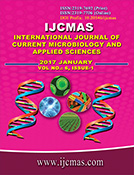


 National Academy of Agricultural Sciences (NAAS)
National Academy of Agricultural Sciences (NAAS)

|
PRINT ISSN : 2319-7692
Online ISSN : 2319-7706 Issues : 12 per year Publisher : Excellent Publishers Email : editorijcmas@gmail.com / submit@ijcmas.com Editor-in-chief: Dr.M.Prakash Index Copernicus ICV 2018: 95.39 NAAS RATING 2020: 5.38 |
Enteropathogenic Escherichia coli (EPEC) was a leading cause of infantile diarrhea in many countries. But this bacteria had never research in flours and porridges consume by infant in Côte d’Ivoire. The aim of this study was to determine the prevalence of EPEC in maize and millet flours and porridges made traditionally. EPEC were research in 996 samples of traditional cereals products, with 404 flours and 592 porridges. These products were taken in five municipalities of Abidjan. The strains were characterized by detection of virulence factors and phylogenetic method. The results revealed that the prevalence of EPEC was 4.1% in millet porridge and 3.4% in maize porridge. This prevalence was 6.4% and 5.4% respectively in millet and maize flours. Most of EPEC; 68.2% isolated was atypical. EPEC detected belong to phylogenetic group A (47.2%), D (28.3%), B1 (13.2%) and B2 (11.3%). In short, traditional flours and porridges from maize and millet used in infant food were risk factors by EPEC contamination, which was potentially pathogen for children.
 |
 |
 |
 |
 |